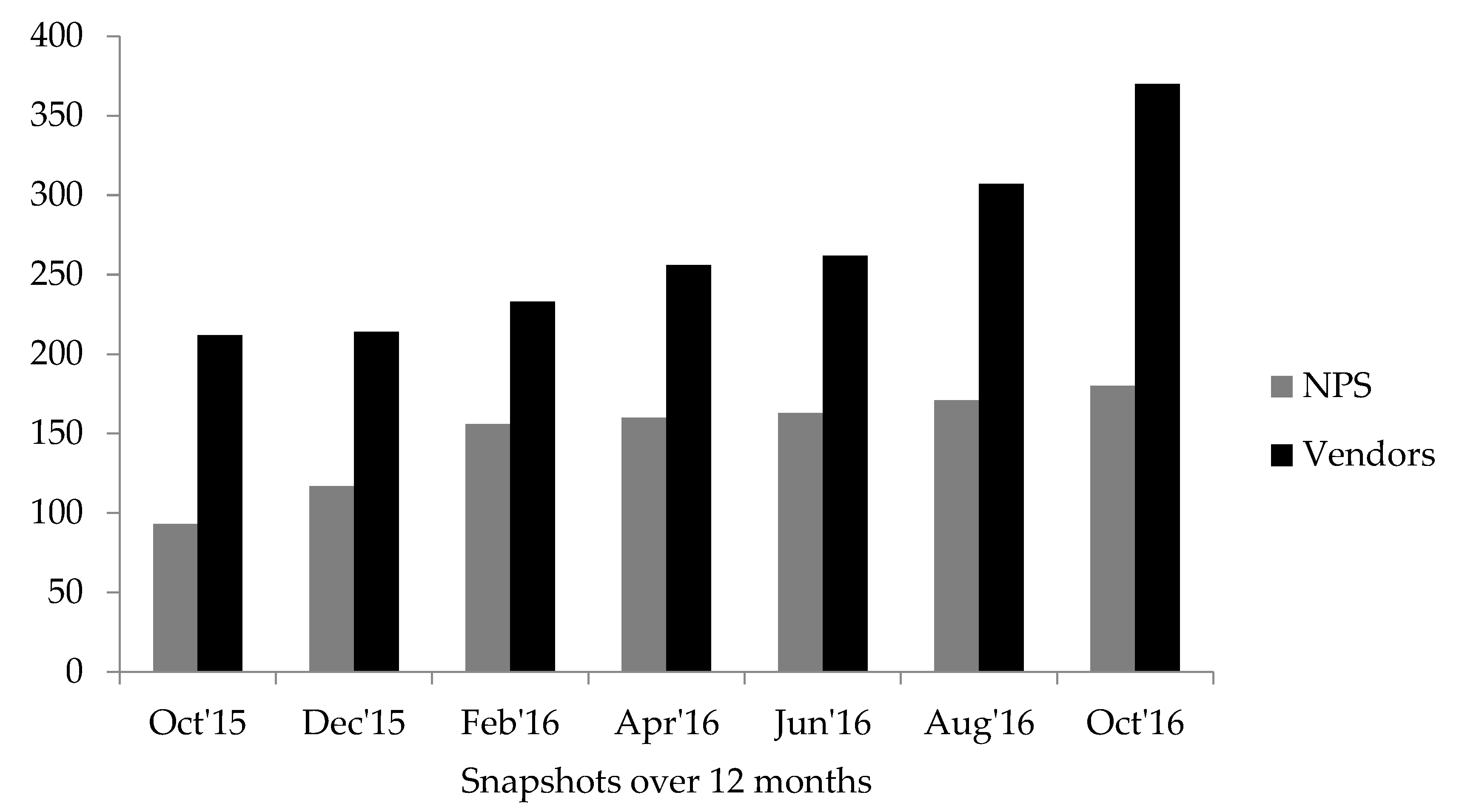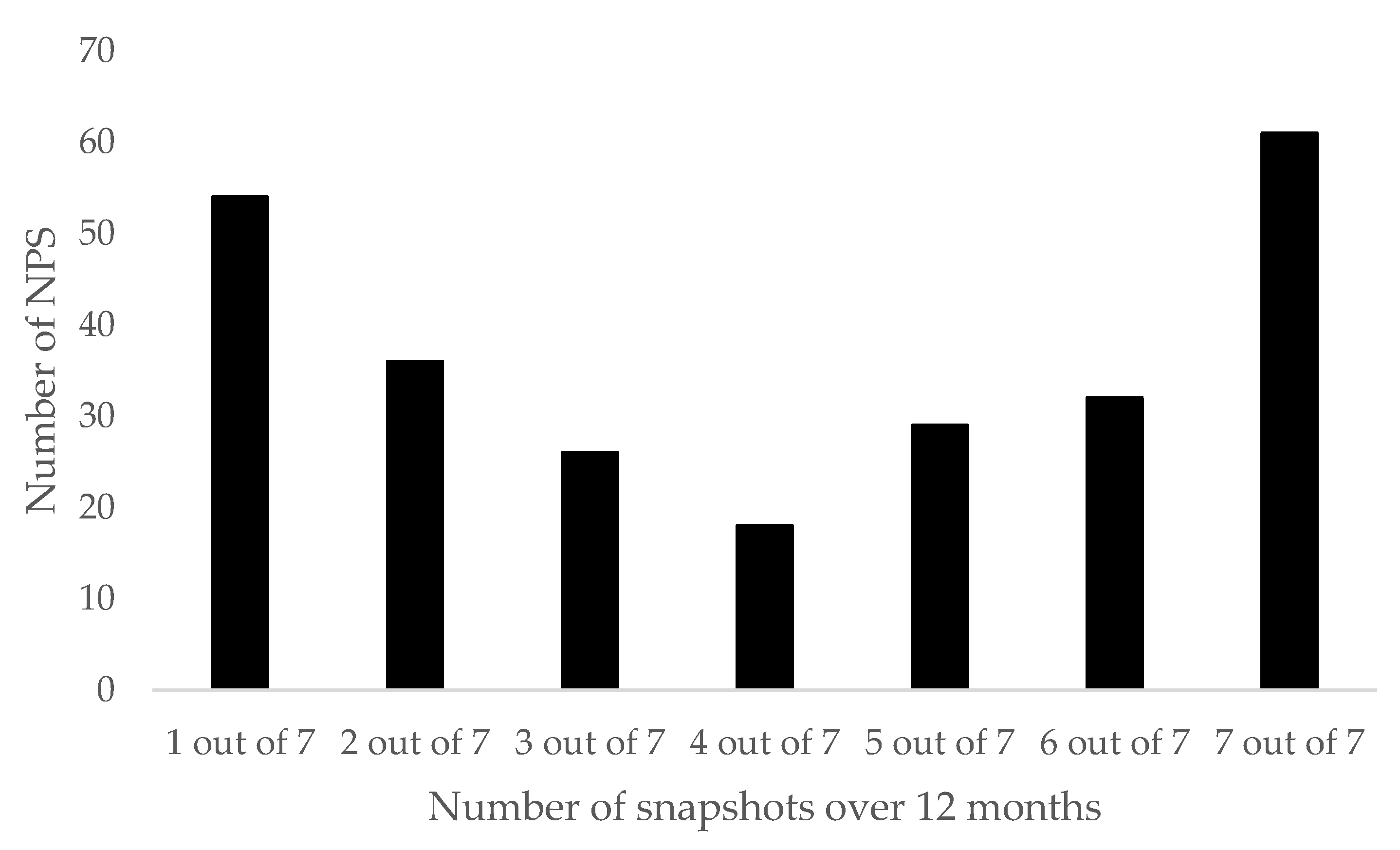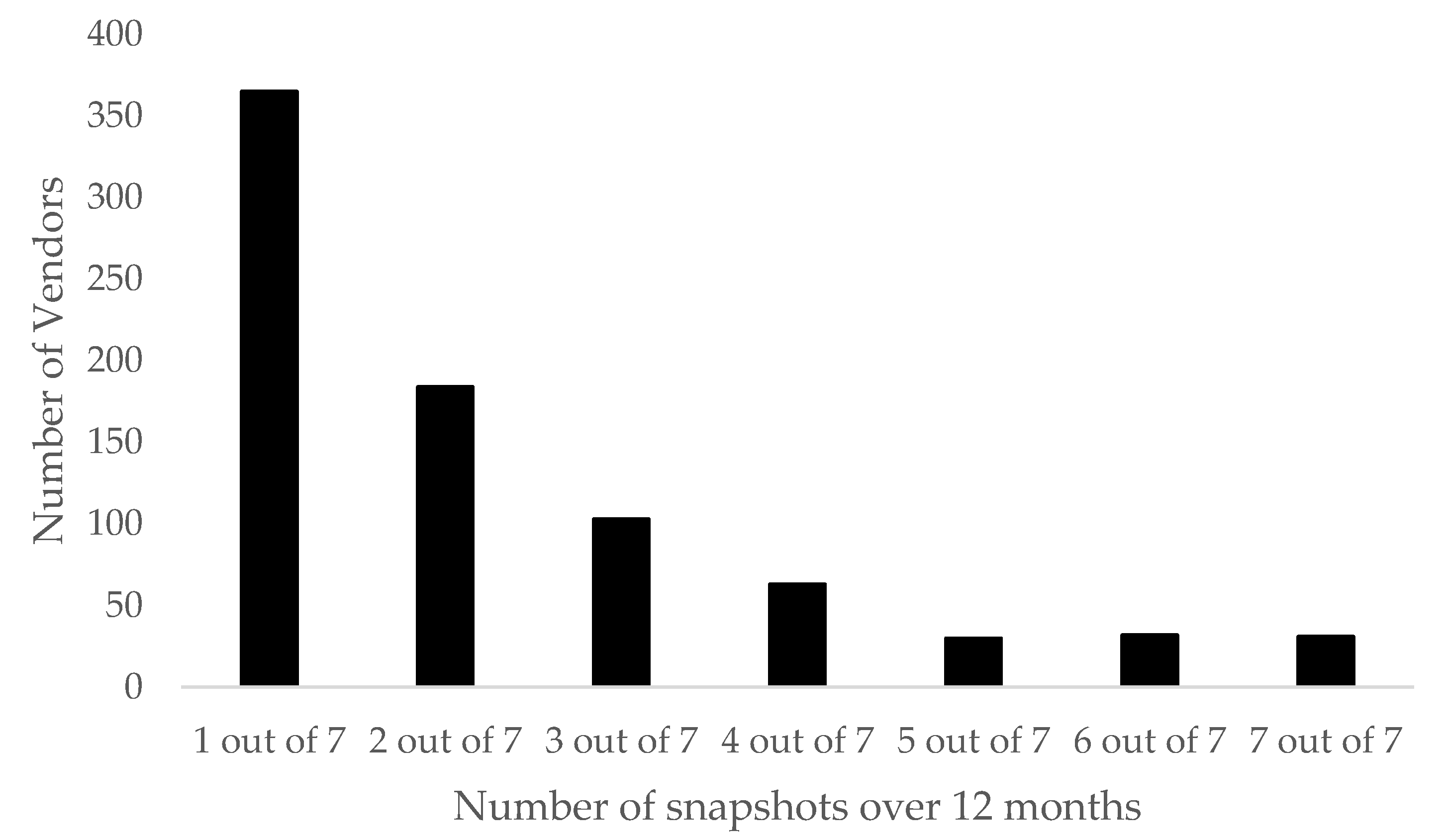The Dynamic Environment of Crypto Markets: The Lifespan of New Psychoactive Substances (NPS) and Vendors Selling NPS
Abstract
:1. Introduction
2. Methods
3. Results
4. Discussion
5. Conclusions
Acknowledgments
Author Contributions
Conflicts of Interest
References
- Global Drug Survey. Global Drug Survey 2016. Available online: https://www.globaldrugsurvey.com/past-findings/the-global-drug-survey-2016-findings/ (accessed on 9 January 2018).
- Walsh, C. Drugs, the Internet and change. J. Psychoact. Drugs 2011, 43, 55–63. [Google Scholar] [CrossRef] [PubMed]
- Van Buskirk, J.; Griffiths, P.; Farrell, M.; Degenhardt, L. Trends in new psychoactive substances from surface and “dark” net monitoring. Lancet Psychiatry 2017, 4, 16–18. [Google Scholar] [CrossRef]
- European Monitoring Centre for Drugs and Drug Addiction (EMCDDA); Europol. EU Drug Markets Report: In-Depth Analysis; Publications Office of the European Union: Luxembourg, Luxembourg, 2016. [Google Scholar]
- EMCDDA. European Drug Report: Trends and Developments; Publications Office of the European Union: Luxembourg, Luxembourg, 2015. [Google Scholar]
- Ledberg, A. The interest in eight new psychoactive substances before and after scheduling. Drug Alcohol Depend. 2015, 152, 73–78. [Google Scholar] [CrossRef] [PubMed]
- UK Government. Psychoactive Substances Act. Available online: http://www.legislation.gov.uk/ukpga/2016/2/contents/enacted (accessed on 9 September 2017).
- Wadsworth, E.; Drummond, C.; Deluca, P. The adherence to UK legislation by online shops selling new psychoactive substances. Drugs Educ. Prev. Policy 2018, 25, 97–100. [Google Scholar] [CrossRef]
- Home Office. New Psychoactive Substances in England: A Review of the Evidence. Available online: https://www.gov.uk/government/publications/new-psychoactive-substances-in-england-a-review-of-the-evidence (accessed on 9 September 2017).
- Barratt, M.J. Silk Road: EBay for drugs. Addiction 2012, 107, 683. [Google Scholar] [CrossRef] [PubMed]
- Seddon, T. Drug policy and global regulatory capitalism: The case of new psychoactive substances (NPS). Int. J. Drug Policy 2014, 25, 1019–1024. [Google Scholar] [CrossRef] [PubMed]
- Tzanetakis, M.; Kamphausen, G.; Werse, B.; von Laufenberg, R. The transparency paradox. Building trust, resolving disputes and optimising logistics on conventional and online drugs markets. Int. J. Drug Policy 2016, 35, 58–68. [Google Scholar] [CrossRef] [PubMed]
- Van Hout, M.C.; Bingham, T. Responsible vendors, intelligent consumers: Silk Road, the online revolution in drug trading. Int. J. Drug Policy 2014, 25, 183–189. [Google Scholar] [CrossRef] [PubMed]
- Van Hout, M.C.; Hearne, E. New psychoactive substances (NPS) on cryptomarket fora: An exploratory study of characteristics of forum activity between NPS buyers and vendors. Int. J. Drug Policy 2017, 40, 102–110. [Google Scholar] [CrossRef] [PubMed]
- Cox, J. Reputation is everything: The role of ratings, feedback and reviews in Cryptomarkets. In Internet and Drug Markets, EMCDDA Insights 21; European Monitoring Centre for Drugs and Drug Addiction (EMCDDA), Ed.; Publications Office of the European Union: Luxembourg City, Luxembourg, 2016; pp. 49–54. [Google Scholar]
- Hardy, R.A.; Norgaard, J.R. Reputation in the Internet black market: An empirical and theoretical analysis of the Deep Web. J. Inst. Econ. 2016, 12, 515–539. [Google Scholar] [CrossRef]
- Aldridge, J.; Décary-Hétu, D. Hidden wholesale: The drug diffusing capacity of online drug cryptomarkets. Int. J. Drug Policy 2016, 35, 7–15. [Google Scholar] [CrossRef] [PubMed]
- Barratt, M.J.; Ferris, J.A.; Winstock, A.R. Use of Silk Road, the online drug marketplace, in the United Kingdom, Australia and the United States. Addiction 2014, 109, 774–783. [Google Scholar] [CrossRef] [PubMed]
- Barratt, M.J.; Lenton, S.; Maddox, A.; Allen, M. ‘What if you live on top of a bakery and you like cakes?’—Drug use and harm trajectories before, during and after the emergence of Silk Road. Int. J. Drug Policy 2016, 35, 50–57. [Google Scholar] [CrossRef] [PubMed]
- Christin, N. Traveling the Silk Road: A Measurement Analysis of a Large Anonymous On-Line Marketplace. Available online: https://www.andrew.cmu.edu/user/nicolasc/publications/Christin-WWW13.pdf (accessed on 9 March 2018).
- Martin, J. Lost on the Silk Road: Online drug distribution and the ‘cryptomarket’. Criminol. Crim. Justice 2014, 14, 351–367. [Google Scholar] [CrossRef]
- Drug Enforcement Agency. Manhattan U.S. Attorney Announces Seizure of Additional $28 Million Worth of Bitcoins Belonging to Ross William Ulbricht, Alleged Owner and Operator of “Silk Road” Website. Available online: www.dea.gov/divisions/nyc/2013/nyc102513.shtml (accessed on 6 May 2017).
- Van Buskirk, J.; Roxburgh, A.; Bruno, R.; Burns, L. Drugs and the Internet, Issue 5, October 2015; National Drug and Alcohol Research Centre: Sydney, Australia, 2015. [Google Scholar]
- Kruithof, K.; Aldridge, J.; Décary-Hétu, D.; Sim, M.; Dujso, E.; Hoorens, S. Internet-Facilitated Drugs Trade: An Analysis of the Size, Scope and the Role of The Netherlands. WODC, Ministerie van Veiligheid en Justitie. 2016. Available online: https://www.rand.org/pubs/research_reports/RR1607.html (accessed on 6 May 2017).
- Van Buskirk, J.; Roxburgh, A.; Farrell, M.; Burns, L. The closure of the Silk Road: What has this meant for online drug trading? Addiction 2014, 109, 517–518. [Google Scholar] [CrossRef] [PubMed]
- CASSANDRA. Cassandra: Computer Assisted Solutions for Studying the Availability aNd Distribution of Novel Psycho Active Substances. Available online: www.projectcassandra.eu (accessed on 14 January 2018).
- Wadsworth, E.; Drummond, C.; Kimergård, A.; Deluca, P. A market on both “sides” of the law: The use of the hidden web for the sale of new psychoactive substances. Hum. Psychopharm. Clin. 2017, 32. [Google Scholar] [CrossRef] [PubMed]
- Décary-Hétu, D.; Quessy-Doré, O. Are repeat buyers in cryptomarkets loyal customers? Repeat business between dyads of cryptomarket vendors and users. Am. Behav. Sci. 2017, 61, 1341–1357. [Google Scholar] [CrossRef]
- Martin, J.; Christin, N. Ethics in cryptomarket research. Int. J. Drug Policy 2016, 35, 84–91. [Google Scholar] [CrossRef] [PubMed]



| Benzodiazepine Analogue | Cathinone | Dissociative | Opioids | Phenethylamine | Synthetic Cannabinoid | Tryptamine | Other |
|---|---|---|---|---|---|---|---|
| Etizolam (Etilaam, Etizola, Eticalm) | 3-CMC (3-chloromethcathinone) | 3-MeO-PCP (3-methoxyphencyclidine) | Fu-F (furanylfentanyl) | 25B-NBOMe (N-bombs, cimbi-36) | AB-CHMINACA (AB-C) | 4-AcO-DMT (o-acetylpsilocin, psilacetin) | 1P-LSD (NP-LAD, 1-Propionyl-d-lysergic acid diethylamide) |
| 3-MMC (3-methylmethcathinone, 3-mephedrone) | DXE (deschloroketamine, DCK, 2’oxo-PCM) | Kratom (ketum, kratum) | 25C-NBOMe (N-bombs, cimbi-82) | MAM-2201 (4′-methyl-AM-2201, 5′′-fluoro-JWH-122) | 4-HO-MET (metocin, methylcybin) | AL-LAD (6-allyl-6-nor-LSD) | |
| 4-CMC (4-chloromethcathinone, clephedrone) | W-18 (4-chloro-N-[1-[2-(4-nitrophenyl)ethyl]-2piperidinylidene]benzenesulfonamide) | 25D-NBOMe (N-bombs) | NM-2201 (CBL-2201) | 4-HO-MiPT (miprocin) | LSA (ergine, d-lyseramide, LAA, LA-111) | ||
| 4-EMC (4-ethylmethcathinone) | 25i-NBOMe (N-bombs, cimbi-5) | “Spice” | 5-MeO-DALT (N,N-Diallyl-5-methoxytryptamine, Foxtrot) | MPA (methylthienylpropamine, methiopropamine, methedrene, syndrax) | |||
| 4-FMC (4-fluoromethcathinone, flephedrone) | 2CB (Tripstacy) | 5-MeO-MiPT (5-Methoxy-N-methyl-N-isopropyltryptamine, Moxy) | MXP (methoxphenidine, 2-MeO-diphenidine) | ||||
| 4F-PV8 (4-Fluoro-α-PHPP, para-fluoro-PV8) | 2CE (Tripstacy) | Salvia | |||||
| 4-MEC (4-methylethcathinone) | 2CI (Tripstacy) | ||||||
| 4-MMC (mephedrone, Mcat, meowmeow, bubble, drone) | 2CP (Tripstacy) | ||||||
| 5-ME (5-methyl-ethylone) | 2FA (2-fluoroamphetamine, PAL-353) | ||||||
| a-PHP (alpha-PHP, PV7, a-pyrrolidinohexiophenone) | 2FMA (2-fluoromethamphetamine) | ||||||
| a-PVP (a-pyrrolidinopentiophenone, flakka, k-prolintane, O-2387) | 3-FPM (3-fluorophenmetrazine, PAL-593) | ||||||
| Dibutylone (bk-DMBDB, booty) | 4FA (4-FMP, PAL-303, Flux, PFA) | ||||||
| Dimethocaine (DMC, larocaine) | 5-EAPB (1-(benzofuran-5-yl)-N-ethylpropan-2-amine) | ||||||
| Ethylone | 5-MAPB (1-(benzofuran-5-yl)-N-methylpropan-2-amine) | ||||||
| MDPV (NRG-1, methylenedioxypyrovalerone) | 6-APB (6-(2-aminopropyl)benzofuran) | ||||||
| Methylone (M1, MDMC, bk-MDMA) | DOC (4-Chloro-2,5-dimethoxyamphetamine) | ||||||
| PV9 (a-POP, alpha-POP) | DOM (2,5-Dimethoxy-4-methylamphetamine) | ||||||
| TH-PVP (3′,4′-tetramethylene-α-Pyrrolidinovalerophenone) | ephedrine | ||||||
| Ethylphenidate (EPH) | |||||||
| MAL (methallylescaline) | |||||||
| MDA (3,4-Methylenedioxyamphetamine) |
© 2018 by the authors. Licensee MDPI, Basel, Switzerland. This article is an open access article distributed under the terms and conditions of the Creative Commons Attribution (CC BY) license (http://creativecommons.org/licenses/by/4.0/).
Share and Cite
Wadsworth, E.; Drummond, C.; Deluca, P. The Dynamic Environment of Crypto Markets: The Lifespan of New Psychoactive Substances (NPS) and Vendors Selling NPS. Brain Sci. 2018, 8, 46. https://doi.org/10.3390/brainsci8030046
Wadsworth E, Drummond C, Deluca P. The Dynamic Environment of Crypto Markets: The Lifespan of New Psychoactive Substances (NPS) and Vendors Selling NPS. Brain Sciences. 2018; 8(3):46. https://doi.org/10.3390/brainsci8030046
Chicago/Turabian StyleWadsworth, Elle, Colin Drummond, and Paolo Deluca. 2018. "The Dynamic Environment of Crypto Markets: The Lifespan of New Psychoactive Substances (NPS) and Vendors Selling NPS" Brain Sciences 8, no. 3: 46. https://doi.org/10.3390/brainsci8030046




